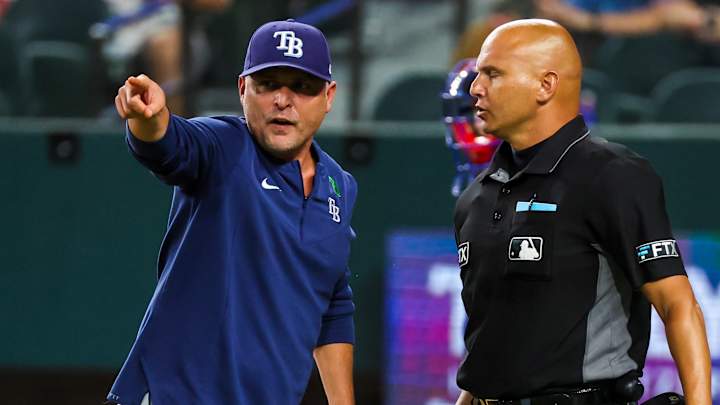MLB Inexperience Suddenly Represents Wisdom at Spring Training

In this story:
Someone’s first spring in big league camp is supposed to be about learning. But this year offers an unusual twist: Maybe it can also be about teaching.
Take Rays third base coach Brady Williams. This is his first year in the gig—his first season on a big league staff in any capacity. He spent the last four years as the manager of the Durham Bulls in Triple A and the decade before that working his way up the organization beginning at the lowest levels. Which, ordinarily, would mean soaking up as much as possible from everyone around him this year. But this season? The dynamic is reversed: Williams may be the most junior member of this coaching staff, but he’s also the one person who has substantive experience with the new rules, such as the pitch clock and shift ban.
Those rules were originally tested last year in Triple A. (So were others like the limitation on pickoff moves and larger bases.) This means the closest a team can get to an expert is someone who just got called up. That dynamic applies on the roster with younger players helping out veterans. But it’s especially important on the coaching staff—where teams are trying to figure out not just how to adjust to the rules, but also how best to communicate those adjustments to their players and how to get the most out of the new landscape strategically.
“Going through it last year in Triple A was a learning process, especially the first month,” Williams says. “That’s why I’m glad that we’re doing it in spring training, right out of the chute, to kind of get all the hiccups out of the way.”
That experience has made Williams a key resource this spring for Rays manager Kevin Cash.
“A lot of our conversations at night are around what he learned last year in Triple A,” says Cash. “It’s what he saw his players do and the adjustments that they made throughout the season.”
Cash and Williams are spending the beginning of spring training as roommates. (The Rays’ usual spring home in Port Charlotte, Fla. was damaged last year by Hurricane Ian, so the team is instead training in February in Lake Buena Vista, the old spring home of the Braves.) Williams’s night-time conversations about strategy have impressed Cash. So has the fact that he’s an excellent cook: Their early spring training dinners have included steak, tuna and sea bass. “He’s really into the presentation,” Cash says. “The plates are perfectly done, it’s like the fish, the spinach underneath it, then the polenta or rice or mashed potatoes underneath, and it’s drizzled with sauce. It’s very impressive.” Cash, for his part, usually does the dishes.
And dinner often comes with a side of rulebook talk. Cash entered spring knowing all the basics: MLB made presentations to managers and coaching staffs about the details of the rules. But just as is the case for the players, there’s no good substitute for actually seeing the rules in action, and that experience comes from Williams. How did performances shift over the course of the season under the rules? What new pockets of strategy did they open up? Where were the biggest surprises or curiosities?
For example, the pitch clock has grabbed early headlines as the most striking of the new additions. But Williams says the one that surprised him the most last season was not the clock, but the limit on mound disengagements, particularly the way teams seemed to be increasingly cautious of it later in the season.
“Last year, as we got into the season, you just felt like there were less pickoffs,” Williams says. “Because as soon as you throw over, you put the advantage on the baserunner.”
If it looks like the new rules will limit the potential for strategy in the game, look again. It’s true that some of the rules close off specific innovations: A historically savvy team like the Rays, for instance, was among the first to make heavy use of the infield shift a decade ago, and now that’s been taken away. But for every potential strategy shut down by the new rules, another one has been opened up, from baserunning to defensive alignments to clock management.
“It just shifts the strategy somewhere else,” Williams says.
And when the Rays settle on those strategies for themselves? The manager will be calling the shots, but chances are, the third base coach will have to weigh in on it.

Emma Baccellieri is a staff writer who focuses on baseball and women's sports for Sports Illustrated. She previously wrote for Baseball Prospectus and Deadspin, and has appeared on BBC News, PBS NewsHour and MLB Network. Baccellieri has been honored with multiple awards from the Society of American Baseball Research, including the SABR Analytics Conference Research Award in historical analysis (2022), McFarland-SABR Baseball Research Award (2020) and SABR Analytics Conference Research Award in contemporary commentary (2018). A graduate from Duke University, she’s also a member of the Baseball Writers Association of America.
Follow emmabaccellieri